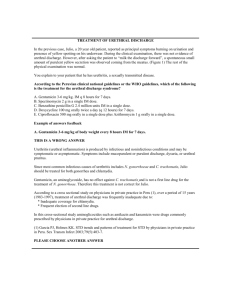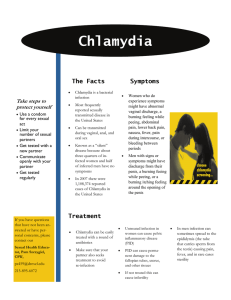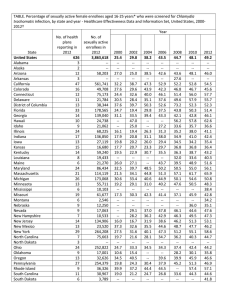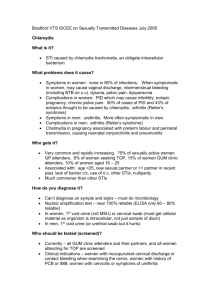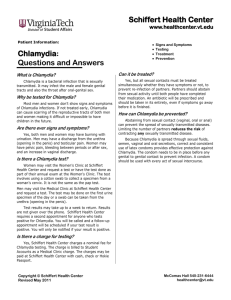Ms. T. does not know which partner she got chlamydia... if it could be her current partner. He has complained...
advertisement
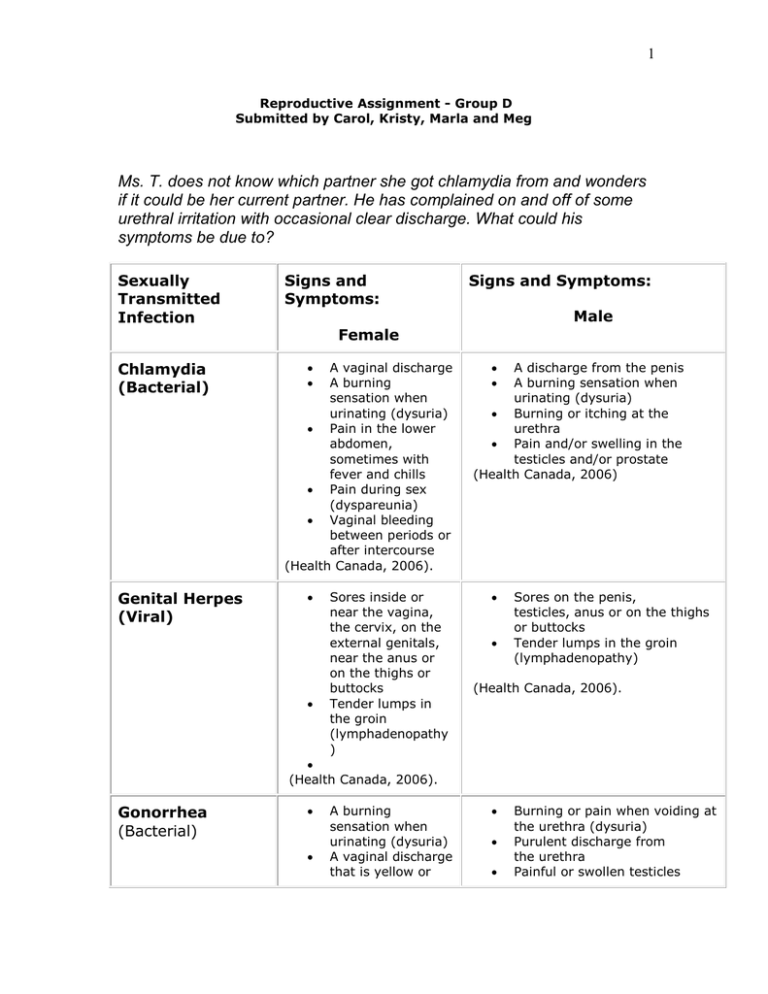
1 Reproductive Assignment - Group D Submitted by Carol, Kristy, Marla and Meg Ms. T. does not know which partner she got chlamydia from and wonders if it could be her current partner. He has complained on and off of some urethral irritation with occasional clear discharge. What could his symptoms be due to? Sexually Transmitted Infection Chlamydia (Bacterial) Genital Herpes (Viral) Signs and Symptoms: Signs and Symptoms: Male Female A vaginal discharge A burning sensation when urinating (dysuria) Pain in the lower abdomen, sometimes with fever and chills Pain during sex (dyspareunia) Vaginal bleeding between periods or after intercourse (Health Canada, 2006). Sores inside or near the vagina, the cervix, on the external genitals, near the anus or on the thighs or buttocks Tender lumps in the groin (lymphadenopathy ) A discharge from the penis A burning sensation when urinating (dysuria) Burning or itching at the urethra Pain and/or swelling in the testicles and/or prostate (Health Canada, 2006) Sores on the penis, testicles, anus or on the thighs or buttocks Tender lumps in the groin (lymphadenopathy) (Health Canada, 2006). (Health Canada, 2006). Gonorrhea (Bacterial) A burning sensation when urinating (dysuria) A vaginal discharge that is yellow or Burning or pain when voiding at the urethra (dysuria) Purulent discharge from the urethra Painful or swollen testicles 2 occasionally bloody Mild or no symptoms Infections in the throat cause few symptoms. (Health Canada, 2006) Human Papillomavirus (HPV) (Viral) Syphilis (Bacterial) May have warts on the vulva, cervix, thigh, anus, and rectum or in the vagina or urethra (Health Canada, 2006). First Signs Painless ulcers to labia majora or minora, vaginal canal, thigh, anus and /or rectum These signs and symptoms may disappear without treatment. (Health Canada, 2006). Secondary Signs: patchy hair loss a rash on the soles of the feet, the palms of the hands or elsewhere on the body fever; swollen glands and muscle and joint pain (Health Canada, 2006). Lymphogranuloma Venereum (LGV) (Bacterial) flu-like symptoms, including: low-grade fever chills fatigue muscle and joint aches (orchitis) Symptoms of rectal infection include: Discharge Anal itching Soreness Bleeding May have painful bowel movements (Health Canada, 2006). May have warts on the penis, scrotum, thigh, anus, rectum or in the urethra (Health Canada, 2006). First Signs Painless ulcers to penis, scrotum, thigh, anus, rectum and/or in the urethra These signs and symptoms may disappear without treatment (Health Canada, 2006). Men will typically notice a chancre present on penis (Berkow, Beers, & Fletcher, 1997) Secondary Signs: patchy hair loss a rash on the soles of the feet, the palms of the hands or else where on the body fever; swollen glands and muscle and joint pain (Health Canada, 2006). flu-like symptoms, including: low-grade fever chills fatigue muscle and joint aches. If infected by anal sex, may have discharge of blood or pus from anus and may experience constipation 3 Lymph nodes may become swollen in your groin (lymphadenopathy), lesions of anal or neck region (Health Canada, 2006). Genital Candidiasis (Fungal) Trichomoniasis (Parasitic) Mycoplasma Genitalium (Bacterial) (Health Canada, 2006). Genital itching or burning. May or may not have "cottage cheese-like" vaginal discharge.(Berkow, Beers, & Fletcher, 1997) Frothy, yellowgreen vaginal discharge with a strong odor. Discomfort during intercourse and voiding. May have irritation and itching in genital area. In rare cases lower abdominal pain (Center of Disease Control and Prevention, 2007). Asymptomatic Vaginal itching Burning on voiding (dysuria) Pain during intercourse (About.com, 2008). Asymptomatic May have urethral pain after voiding or intercourse May notice a clear to white discharge from penis. (Berkow, Beers, & Fletcher, 1997) Asymptomatic (Berkow, Beers, & Fletcher, 1997, pp.1032) May have temporarily irritation along cavernous urethra Mild discharge Slight burning after voiding or ejaculation (Center of Disease Control and Prevention, 2007). Asymptomatic Urethral discharge Burning on urination (dysuria) Pain and swelling of the joints (arthritis) (About.com, 2008). Sexually transmitted infections (STIs) are infections that are contracted during oral, anal, or vaginal sex between sexual partners (Health Canada, 2006). Individuals may not realize that they have been exposed to a STI because there are few initials signs or symptoms of infection. By the time these signs or symptom are seen the individual may have exposed several other sexual partners to the 4 STI (Health Canada, 2006). These infections can be either viral, bacterial, fungal, parasitic or protozoan (Health Canada, 2006). In the table below are the most common STIs and their signs and symptoms for both female and male. Chlamydia Chlamydia trachomatis (CT) or chlamydia as it is commonly known is a prevalent gram-negative sexually transmitted infection. Youth and young adults, particularly those under 20 years of age, who are sexually active are disproportionately represented of the reported cases of chlamydia in Canada (Public Health Agency of Canada, 2007; Morgan, 2006). It is a leading cause of nongonococcal urethritis (Anti-infective Review Panel, 2005). Symptoms of chlamydia in males, as per the table above, include urethral discharge, urethritis, urethral itch, dysuria, testicular pain, conjunctivitis, and proctitis or they may also be asymptomatic (Public Health Agency of Canada, 2007). Symptoms most reported in females, as per the table above, include dysuria, cervicitis, proctitis, lower abdominal pain, dyspareunia, conjunctivitis and abnormal vaginal bleeding but often they are asymptomatic (Public Health Agency of Canada, 2007). Chlamydia is often responsible for pelvic inflammatory disease (PID) (Morgan, 2006). Research has also found that "79 out of 1025 women (7.8%) were infertile because of post-salpingitic tubal occlusion" after contracting Chlamydia (BBC News, 2005). Chlamydia can also cause infertility in males by decreasing the concentration and motility of sperm. Also chlamydia seems to cause defects in the DNA of the sperm (BBC News, 2007). Ms. T's partner's symptoms could be due to several forms of sexually transmitted infections (STIs). Very likely based on the urethral irritation and clear urethral discharge, the organism responsible for Ms. T's partner's symptoms is chlamydia. It is present in 25% - 60% of men with nongonoccocus urethritis (NGU) (Morgan, 2006). Clinically, chlamydia cannot be differentiated from gonococcus. 5 Although the age of Ms. T's partner is unknown, presumably he is older than the usual 20 year olds who represent the age group most often infected with chlamydia. This would by no means rule it out though as the cause. Chlamydia is common among heterosexuals, those who have multiple and new partners and those who have a history of gonnococcus (Morgan, 2006). Other Possible Causes of Symptoms Other possible causative organisms for Ms. T's partner's symptoms may be herpes simplex virus, mycoplasma genitalium or ureaplasma urealyticum (Public Health Agency of Canada, 2007). Given the urethral discharge described by Ms. T's partner, it is unlikely, although possible, that he may also have epididymitis, which is usually caused by chlamydia or gonoccocus (Public Health Agency of Canada, 2007). Since the primary symptom of epididymitis is pain, and there was no mention of this as a symptom in the case study, this condition is most unlikely (Morgan & McCance, 2006). Ms. T's partner should have a culture of his penile discharge as well as an urine culture to identify the causative organism(s). If these swabs are negative for chlamydia or trichomoniasis then mycoplasma is most likely the cause. Mycolplasma is the most common organism in non-chlamydial and nongonoccocal urethritis in men (About.com, 2008). Urethritis can also occur without the presence of infection. These symptoms of urethral irritation and clear discharge, also fit with a male who has post-traumatic urethritis, seen in men who require frequent catheterization (especially with a latex catheter) (Elrod & Plewa, 2007). Chronic urethritis can lead to urethral strictures. Compare and contrast three types of precocious puberty. Precocious puberty is defined as "sexual maturation before 6 in black girls or age 7 in white girls, and before age 9 in boys" (Morgan & McCance, 2006, p, 773). Kaplowitz (2007) defines the term slightly differently but agrees that basically precocious puberty refers to children who demonstrate hormonal and physical signs of puberty at an earlier age than that considered normal. Three types of precocious puberty are: 1) Isosexual puberty - this describes a form that is dependent or independent of gonadotropin-releasing hormone (GnRH). In true isosexual puberty it is dependent upon GnRH and "occurs when the hypothalmic-pituitary-gonadal axis is working normally but prematurely" (Morgan & McCance, 2006, p. 773). This axis basically describes a feedback mechanism that involves follicle stimulating hormone (FSH) and leutinizing hormone (LH), which is further described in an article by Feinberg, Bromer, and Catherino (2005). 2) Heterosexual precocious puberty describes conditions whereby "children develop some secondary sex characteristics of the opposite sex" (Morgan & McCance, 2006, p. 773). 6 3) Incomplete precocious puberty describes a condition whereby children develop only partial yet appropriate secondary sex characteristics. This type is often present in children who are obese (Morgan & McCance, 2006). References: About.com. (2008, March). Sexually transmitted diseases: What are the symptoms of mycoplasma genitalium? Retrieved June 9, 2008 from http://std.about.com/od/symptomsfaq/f/mycosymfaq.htm Anti-infective Review Panel. (2005, 10th Anniversary Ed). Anti-infective guidelines for community-acquired infections. Toronto, ON: MUMS Guidelines Clearinghouse. BBC News. (2005, October, 16). Chlamydia and infertility. Retrieved June 9, 2008 from http://news.bbc.co.uk/1/hi/programmes/panorama/4347858.stm BBC News. (2007, October, 15). Chlamydia damages male fertility. Retrieved June 9, 2008 from http://news.bbc.co.uk/2/hi/health/7044602.stm Berkow, R., Beers, M. H., & Fletcher, A.J. (Eds.). (1997). Sexually transmitted diseases. The Merck manual of medical information: Home edition. (pp. 1025-1035). New York, NY: Pocket Books. Center of Disease Control and Prevention. (2007, December). Sexually transmitted diseases: Trichomoniasis - CDC Fact Sheet. Retrieved June 9, 2008 from http://www.cdc.gov/STD/Trichomonas/STDFact-Trichomoniasis.htm#WhatIs Elrod, W & Plewa, M. (2007). Urethritis, Male. emedicine. Accessed online June 8, 2008 from WebMed. http://www.emedicine.com/emerg/topic623.htm Feinberg, E.C., Bromer, J.G., & Catherino, W.H. (2005, March). The evolution of in vitro fertilization: Integration of pharmacology, technology and clinical care. Journal of Pharmacology And Experimental Therapeutics. Retrieved on June 7, 2008 from http://jpet.aspetjournals.org/cgi/content/full/313/3/935 Health Canada. (2006, May 19). Sexually transmitted infections (STI): Diseases and conditions. Retrieved June 9, 2008 from http://www.hc-sc.gc.ca/dc- ma/sti-its/index-eng.php Kaplowitz, P. B. (2007, September 28). Precocious puberty. Emedicine from WebMD. Retrieved June 6, 2008 from http://www.emedicine.com/ped/TOPIC1882.HTM Morgan, K. (2006). Sexually transmitted infections. In K. L. McCance & S. E. Huether (Eds.), Pathophysiology: The biologic basis for disease in adults and children (5th ed., pp. 863-891). St. Louis, MI: Elsevier Mosby. Morgan, K., & McCance, K.L. (2006). Alterations of the reproductive system. In K. L. McCance & S. E. Huether (Eds.), Pathophysiology: The biologic basis for disease in adults and children (5th ed., pp. 771-8861). St. Louis, MI: Elsevier 7 Mosby. Public Health Agency of Canada. (2007, October). Canadian guidelines on sexually transmitted infections, Chlamydia, 2006 Edition. Retrieved on June 6, 2008 from http://www.phac-aspc.gc.ca/std-mts/sti_2006/pdf/05sti2006b_e.pdf Public Health Agency of Canada. (2007, October). Canadian guidelines on sexually transmitted infections, Epididymitis, 2006 Edition. Retrieved on June 9, 2008 from http://www.phac-aspc.gc.ca/std-mts/sti_2006/pdf/04sti2006b_e.pdf Public Health Agency of Canada. (2007, October). Canadian guidelines on sexually transmitted infections, Urethritis, 2006 Edition. Retrieved on June 6, 2008 from http://www.phac-aspc.gc.ca/std-mts/sti_2006/pdf/04sti2006g_e.pdf Salt Lake Regional Medical Center. (2006). Urethritis - chronic. In A.D.A.M. health library. Retrieved June 8, 2008 http://www.saltlakeregional.com/adam/Health%20Illustrated%20Encyclope dia/1/001277/
